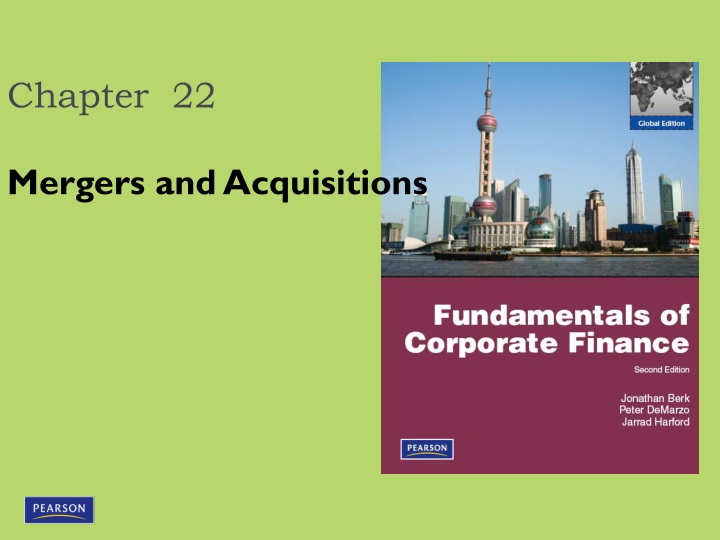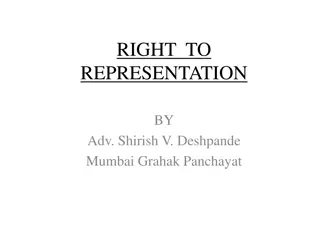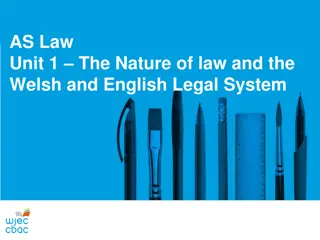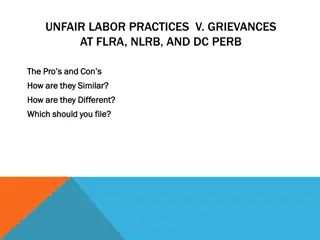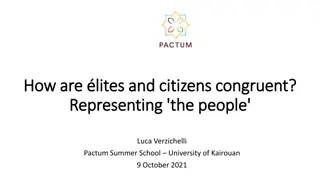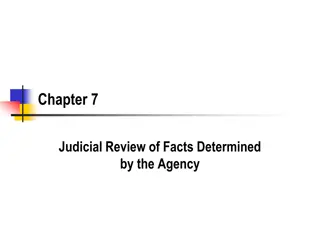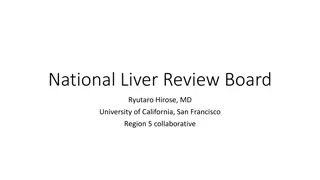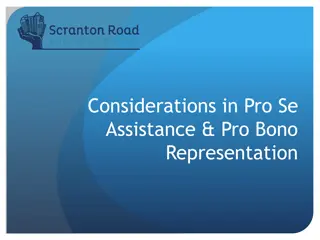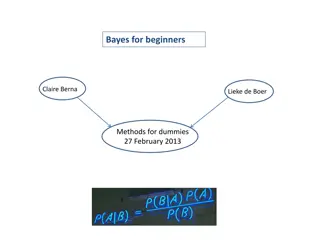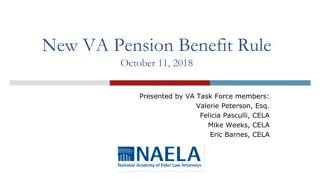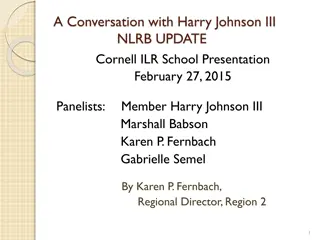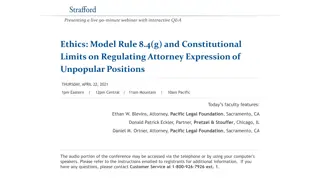NLRB Representation Case Rule Changes Overview
Explore the procedural history and key changes in NLRB representation case rule changes. Learn about filing the petition, initial processing, pre-election procedures, and more.
Download Presentation

Please find below an Image/Link to download the presentation.
The content on the website is provided AS IS for your information and personal use only. It may not be sold, licensed, or shared on other websites without obtaining consent from the author.If you encounter any issues during the download, it is possible that the publisher has removed the file from their server.
You are allowed to download the files provided on this website for personal or commercial use, subject to the condition that they are used lawfully. All files are the property of their respective owners.
The content on the website is provided AS IS for your information and personal use only. It may not be sold, licensed, or shared on other websites without obtaining consent from the author.
E N D
Presentation Transcript
Chapter 22 Mergers and Acquisitions
Chapter 22 Mergers and Acquisitions
Chapter Outline 22.1 Background and Historical Trends 22.2 Market Reaction to a Takeover 22.3 Reasons to Acquire 22.4 The Takeover Process 22.5 Takeover Defenses 22.6 Who Gets the Value Added from a Takeover?
Learning Objectives Discuss the types of mergers and trends in merger activity. Understand the stock price reactions to takeover announcements. Critically evaluate the different reasons to acquire. Follow the major steps in the takeover process.
Learning Objectives (contd) Discuss the main takeover defenses. Identify factors that determine who gets the value-added in a merger.
22.1 Background and Historical Trends The market for corporate control Acquirer (aka bidder) Target Two primary mechanisms Acquisition Merger
22.1 Background and Historical Trends Merger Waves Peaks of heavy takeover activity followed by troughs of few transactions. Merger activity is greater during economic expansions than contractions Also correlates with bull markets
Table 22.1 Twenty Largest Merger Transactions, August 2000 July 2010
Figure 22.1 Percentage of Public Companies Taken Over Each Quarter, 1926-2010
22.1 Background and Historical Trends Types of Mergers Horizontal merger Target and acquirer are in the same industry Vertical merger Target s industry buys or sells to acquirer s industry Conglomerate merger Target and bidder are in different industries
22.1 Background and Historical Trends Types of Mergers Stock swap Cash merger or acquisition Payments can be very complex Usually some combination of forms of payment
22.2 Market Reaction to a Takeover Most acquirers pay a substantial acquisition premium. TABLE 22.2 Average Acquisition Premium and Stock Price Reactions to Mergers
22.2 Market Reaction to a Takeover Three questions: Why do acquirers pay a premium? Why does the price of the target rise by less than the premium? If the merger is a good idea, why does the acquirer s price not have a large increase?
22.3 Reasons to Acquire Acquirer might be able to add economic value as a result of the acquisition. Synergies
22.3 Reasons to Acquire Economies of Scale and Scope Economies of scale Savings from producing goods in high volume Economies of scope Savings from combining the marketing and distribution of related products
22.3 Reasons to Acquire Vertical Integration Merger of two companies in the same industry that make products required at different stages of the production cycle. Principal benefit is coordination
22.3 Reasons to Acquire Expertise May be more efficient to purchase a company for its talent pool that is already a functioning unit Monopoly Gains Antitrust laws
22.3 Reasons to Acquire Efficiency Gains Elimination of duplication Improvement in poor management Tax Savings from Operating Losses Can t write off a tax loss unless you have a profit elsewhere.
Example 22.1 Taxes for a Merged Corporation Problem: Consider two firms, Ying Corporation and Yang Corporation. Both corporations will either make $50 million or lose $20 million every year with equal probability. The only difference is that the firms profits are perfectly negatively correlated. That is, any year Yang Corporation earns $50 million, Ying Corporation loses $20 million, and vice versa. Assume that the corporate tax rate is 34%.
Example 22.1 Taxes for a Merged Corporation Problem (cont d): What are the total expected after tax profits of both firms when they are two separate firms? What are the expected after-tax profits if the two firms are combined into one corporation called Ying-Yang Corporation, but are run as two independent divisions? (Assume it is not possible to carry back or carry forward any losses.)
Example 22.1 Taxes for a Merged Corporation Solution: Plan: We need to calculate the after-tax profits of each firm in both the profitable and unprofitable states by multiplying profits by (1 tax rate). We can then compute expected after-tax profits as the weighted average of the after-tax profits in the profitable and unprofitable states. If the firms are combined, their total profits in any year would always be $50 million - $20 million = $30 million, so the after-tax profit will always be $30 (1- tax rate).
Example 22.1 Taxes for a Merged Corporation Execute: Let s start with Ying Corporation. In the profitable state, the firm must pay corporate taxes, so after-tax profits are $50 (1 - 0.34) = $33 million. No taxes are owed when the firm reports losses, so the after-tax profits in the unprofitable state are -$20 million. Thus, the expected after-tax profits of Ying Corporation are 33(0.5) + (- 20)(0.5) = $6.5 million.
Example 22.1 Taxes for a Merged Corporation Execute (cont d): Because Yang Corporation has identical expected profits, its expected profits are also $6.5 million. Thus, the total expected profit of both companies operated separately is $13 million. The merged corporation, Ying-Yang Corporation, would have after-tax profits of $30 (1-0.34) = $19.8 million.
Example 22.1 Taxes for a Merged Corporation Evaluate: Ying-Yang Corporation has significantly higher after-tax profits than the total stand-alone after-tax profits of Ying Corporation and Yang Corporation. This is because the losses on one division reduce the taxes on the other division s profits.
Example 22.1a Taxes for a Merged Corporation Problem: Consider two firms, Tally Corporation and Ho Corporation. Both corporations will either make $100 million or lose $50 million every year with equal probability. The only difference is that the firms profits are perfectly negatively correlated. That is, any year Tally Corporation earns $100 million, Ho Corporation loses $50 million, and vice versa. Assume that the corporate tax rate is 34%.
Example 22.1a Taxes for a Merged Corporation Problem (cont d): What are the total expected after tax profits of both firms when they are two separate firms? What are the expected after-tax profits if the two firms are combined into one corporation called Tally-Ho Corporation, but are run as two independent divisions? (Assume it is not possible to carry back or carry forward any losses.)
Example 22.1a Taxes for a Merged Corporation Solution: Plan: We need to calculate the after-tax profits of each firm in both the profitable and unprofitable states by multiplying profits by (1 tax rate). We can then compute expected after-tax profits as the weighted average of the after-tax profits in the profitable and unprofitable states. If the firms are combined, their total profits in any year would always be $100 million - $50 million = $50 million, so the after-tax profit will always be $50 (1- tax rate).
Example 22.1a Taxes for a Merged Corporation Execute: Let s start with Tally Corporation. In the profitable state, the firm must pay corporate taxes, so after-tax profits are $100 (1 - 0.34) = $66 million. No taxes are owed when the firm reports losses, so the after-tax profits in the unprofitable state are -$50 million. Thus, the expected after-tax profits of Tally Corporation are 66(0.5) + (- 50)(0.5) = $8.0 million.
Example 22.1a Taxes for a Merged Corporation Execute (cont d): Because Ho Corporation has identical expected profits, its expected profits are also $8.0 million. Thus, the total expected profit of both companies operated separately is $16 million. The merged corporation, Tally-Ho Corporation, would have after-tax profits of $50 (1-0.34) = $33 million.
Example 22.1a Taxes for a Merged Corporation Evaluate: Tally-Ho Corporation has significantly higher after-tax profits than the total stand-alone after-tax profits of Tally Corporation and Ho Corporation. This is because the losses on one division reduce the taxes on the other division s profits.
22.3 Reasons to Acquire Diversification Risk reduction Debt capacity and borrowing costs Liquidity
22.3 Reasons to Acquire Earnings growth It is possible that two companies combined can have higher earnings per share than the premerger earnings per share of either company, even if the merger creates no economic value.
Example 22.2 Mergers and Earnings Per Share Problem: Consider two corporations that both have earnings of $5 per share. The first firm, OldWorld Enterprises, is a mature company with few growth opportunities. It has 1 million shares that are currently outstanding, priced at $60 per share. The second company, NewWorld Corporation, is a young company with much more lucrative growth opportunities. Consequently, it has a higher value: Although it has the same number of shares outstanding, its stock price is $100 per share.
Example 22.2 Mergers and Earnings Per Share Problem (cont d): Assume NewWorld acquires OldWorld using its own stock, and the takeover adds no value. In a perfect market, what is the value of NewWorld after the acquisition? At current market prices, how many shares must NewWorld offer to OldWorld s shareholders in exchange for their shares? Finally, what are NewWorld s earnings per share after the acquisition?
Example 22.2 Mergers and Earnings Per Share Solution: Plan: Because the takeover adds no value, the post-takeover value of NewWorld is just the sum of the values of the two separate companies: 100 1 million + 60 1 million = $160 million. To acquire OldWorld, NewWorld must pay $60 million. We need to first calculate how many shares NewWorld must issue to pay OldWorld shareholders $60 million. The ratio of NewWorld shares issued to OldWorld Shares will give us the exchange ratio.
Example 22.2 Mergers and Earnings Per Share Plan (cont d): Once we know how many new shares will be issued, we can divide the total earnings of the combined company by the new total number of shares outstanding to get the earnings per share.
Example 22.2 Mergers and Earnings Per Share Execute: At its pre-takeover stock price of $100 per share, the deal requires issuing 600,000 shares ($60 million / $100 = 600,000). As a group, OldWorld s shareholders will then exchange 1 million shares in OldWorld for 600,000 shares in NewWorld. The exchange ratio is the ratio of issued shares to exchanged shares: 600,000/1 million = 0.6. Therefore, each OldWorld shareholder will get 0.6 share in NewWorld for each 1 share in OldWorld
Example 22.2 Mergers and Earnings Per Share Execute (cont d): Notice that the price per share of NewWorld stock is the same after the takeover: The new value of NewWorld is $160 million and there are 1.6 million shares outstanding, giving it a stock price of $100 per share. However, NewWorld s earnings per share have changed. Prior to the takeover, both companies earned $5/share 1 million shares = $5 million. The combined corporation thus earns $10 million.
Example 22.2 Mergers and Earnings Per Share Execute (cont d): There are 1.6 million shares outstanding after the takeover, so NewWorld s post-takeover earnings per share are $10million 1.6millionshares = $6.25/share EPS = By taking over OldWorld, NewWorld has raised its earnings per share by $1.25.
Example 22.2 Mergers and Earnings Per Share Evaluate: Because no value was created, we can think of the combined company as simply a portfolio of NewWorld and OldWorld. Although the portfolio has higher total earnings per share, it also has lower growth because we have combined the low-growth OldWorld with the high-growth NewWorld. The higher current earnings per share has come at a price lower earnings per share growth.
Example 22.2a Mergers and Earnings Per Share Problem: Consider two corporations that both have earnings of $8 per share. The first firm, Beenaround, is a mature company with few growth opportunities. It has 2 million shares that are currently outstanding, priced at $50 per share. The second company, Movenin Corporation, is a young company with much more lucrative growth opportunities. Consequently, it has a higher value: Although it has the same number of shares outstanding, its stock price is $80 per share.
Example 22.2a Mergers and Earnings Per Share Problem (cont d): Assume Movenin acquires Beenaround using its own stock, and the takeover adds no value. In a perfect market, what is the value of Movenin after the acquisition? At current market prices, how many shares must Movenin offer to Beenaround s shareholders in exchange for their shares? Finally, what are Movenin s earnings per share after the acquisition?
Example 22.2a Mergers and Earnings Per Share Solution: Plan: Because the takeover adds no value, the post-takeover value of Movenin is just the sum of the values of the two separate companies: 50 2 million + 80 2 million = $260 million. To acquire Beenaround, Movenin must pay $100 million. We need to first calculate how many shares Movenin must issue to pay Beenaround shareholders $100 million. The ratio of Movenin shares issued to Beenaround Shares will give us the exchange ratio.
Example 22.2a Mergers and Earnings Per Share Plan (cont d): Once we know how many new shares will be issued, we can divide the total earnings of the combined company by the new total number of shares outstanding to get the earnings per share.
Example 22.2a Mergers and Earnings Per Share Execute: At its pre-takeover stock price of $80 per share, the deal requires issuing 1,250,000 shares ($100 million / $80 = 1,250,000). As a group, Beenaround s shareholders will then exchange 2 million shares in Beenaround for 1,250,000 shares in Movenin. The exchange ratio is the ratio of issued shares to exchanged shares: 1,250,000/2 million = 0.625. Therefore, each Beenaround shareholder will get 0.625 share in Movenin for each 1 share in Beenaround
Example 22.2a Mergers and Earnings Per Share Execute (cont d): Notice that the price per share of Movenin stock is the same after the takeover: The new value of Movenin is $260 million and there are 3.25 million shares outstanding, giving it a stock price of $80 per share. However, Movenin s earnings per share have changed. Prior to the takeover, both companies earned $8/share 2 million shares = $16 million. The combined corporation thus earns $32 million.
Example 22.2a Mergers and Earnings Per Share Execute (cont d): There are 3.25 million shares outstanding after the takeover, so Movenin s post-takeover earnings per share are $32million 3.25millionshares = $9.85/share EPS = By taking over Beenaround, Movenin has raised its earnings per share by $1.85.
Example 22.2a Mergers and Earnings Per Share Evaluate: Because no value was created, we can think of the combined company as simply a portfolio of Movenin and Beenaround. Although the portfolio has higher total earnings per share, it also has lower growth because we have combined the low-growth Beenaround with the high-growth Movenin. The higher current earnings per share has come at a price lower earnings per share growth.
Example 22.3 Mergers and the Price-Earnings Ratio Problem: Calculate NewWorld s price-earnings ratio, before and after the takeover described in Example 22.2.
Example 22.3 Mergers and the Price-Earnings Ratio Solution: Plan: The price-earnings ratio is price per share / earnings per share. NewWorld s price per share is $100 both before and after the takeover, and its earnings per share is $5 before and $6.25 after the takeover.
